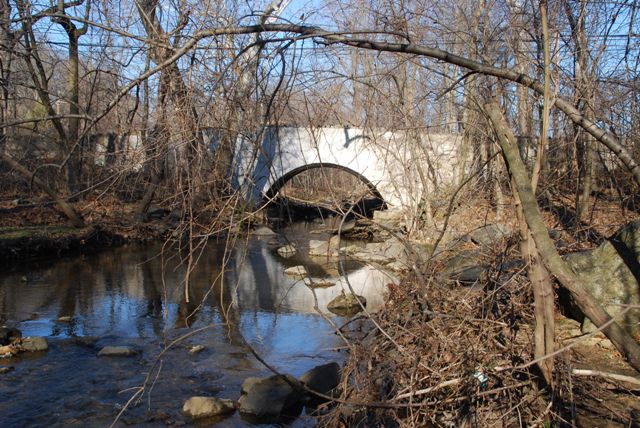We Recommend:
Bach Steel - Experts at historic truss bridge restoration.
BridgeHunter.com Phase 1 is released to the public! - Visit Now
Darby Paoli Road Bridge

Primary Photographer(s): Elaine Deutsch
Bridge Documented: January 7, 2012
Rural: Delaware County, Pennsylvania: United States
By Builder/Contractor: Unknown
2006
21.0 Feet (6.4 Meters)
24.0 Feet (7.3 Meters)
17 Feet (5.18 Meters)
1 Main Span(s)
23101500501972

View Information About HSR Ratings
Bridge Documentation
View Archived National Bridge Inventory Report - Has Additional Details and Evaluation
This bridge is an example of an arch bridge which has a brick arch ring but stone spandrel walls. It also has an unusual detail on the parapet where the top of the railing has stones that give it a bumpy or even perhaps a somewhat crenelated appearance. Unfortunately someone was allowed to go crazy with the shotcrete around this once-beautiful bridge so in many respects the bridge looks like a concrete arch, with the stone and brick obscured. The National Bridge Inventory gives an 1840 construction date for the bridge which does not appear to refer to this bridge, but may reference a the date for a previous bridge at this location.
Information and Findings From Pennsylvania's Historic Bridge InventoryDiscussion of Bridge The one-span, 24'-long, brick arch bridge, according to inspection reports, has a brick arch ring and rubble masonry spandrel walls and parapets with capstones set in a crenelated pattern. The arch intrados, spandrel walls, and both faces of the parapets have been inappropriately coated with concrete, completely obscuring the masonry. At least two coats of shotcrete are evident, the most recent application dates to ca. 1990. The upstream wingwalls lean outward and have been strengthened twice, once with the addition of stone buttresses (ca. 1950) and most recently by timber braces (ca. 1990). The builder and date of construction are undocumented by available state and county records. The bridge dates stylistically to ca. 1905 based on the 1903-1908 dates of construction of at least 13 identified brick arch bridges in Delaware and Chester counties. There are approximately 25 brick arch highway bridges from 1870-1910 in the state. This short, one-span example has lost integrity of original design. Other less altered examples in the region better represent the technological and historical significance of brick arch bridges within the context of countybuilt bridge types. Discussion of Surrounding Area The bridge carries 1 lane of a 2 lane highway over a stream in a suburban setting of residences on large lots. Approximately 50' southeast of the bridge is the gate to Radnor Township Park, located on the the casually landscaped grounds of a former late-19thcentury gentleman's estate. The ca. 1890 Italianate house, "the Willows," has been converted to offices and banquet facilities. The park features gardens, a duck pond, and walking trails. The bridge is located on a public highway that predates the estate and is its northern boundary. It is not historically associated with the estate development. North of the bridge on Darby-Paoli and Brook roads are a series of late-20th-century residential subdivisions. Bridge Considered Historic By Survey: No |
![]()
Photo Galleries and Videos: Darby Paoli Road Bridge
Bridge Photo-Documentation
Original / Full Size PhotosA collection of overview and detail photos. This gallery offers photos in the highest available resolution and file size in a touch-friendly popup viewer.
Alternatively, Browse Without Using Viewer
![]()
Bridge Photo-Documentation
Mobile Optimized PhotosA collection of overview and detail photos. This gallery features data-friendly, fast-loading photos in a touch-friendly popup viewer.
Alternatively, Browse Without Using Viewer
![]()
Maps and Links: Darby Paoli Road Bridge
Coordinates (Latitude, Longitude):
Search For Additional Bridge Listings:
Bridgehunter.com: View listed bridges within 0.5 miles (0.8 kilometers) of this bridge.
Bridgehunter.com: View listed bridges within 10 miles (16 kilometers) of this bridge.
Additional Maps:
Google Streetview (If Available)
GeoHack (Additional Links and Coordinates)
Apple Maps (Via DuckDuckGo Search)
Apple Maps (Apple devices only)
Android: Open Location In Your Map or GPS App
Flickr Gallery (Find Nearby Photos)
Wikimedia Commons (Find Nearby Photos)
Directions Via Sygic For Android
Directions Via Sygic For iOS and Android Dolphin Browser
USGS National Map (United States Only)
Historical USGS Topo Maps (United States Only)
Historic Aerials (United States Only)
CalTopo Maps (United States Only)

